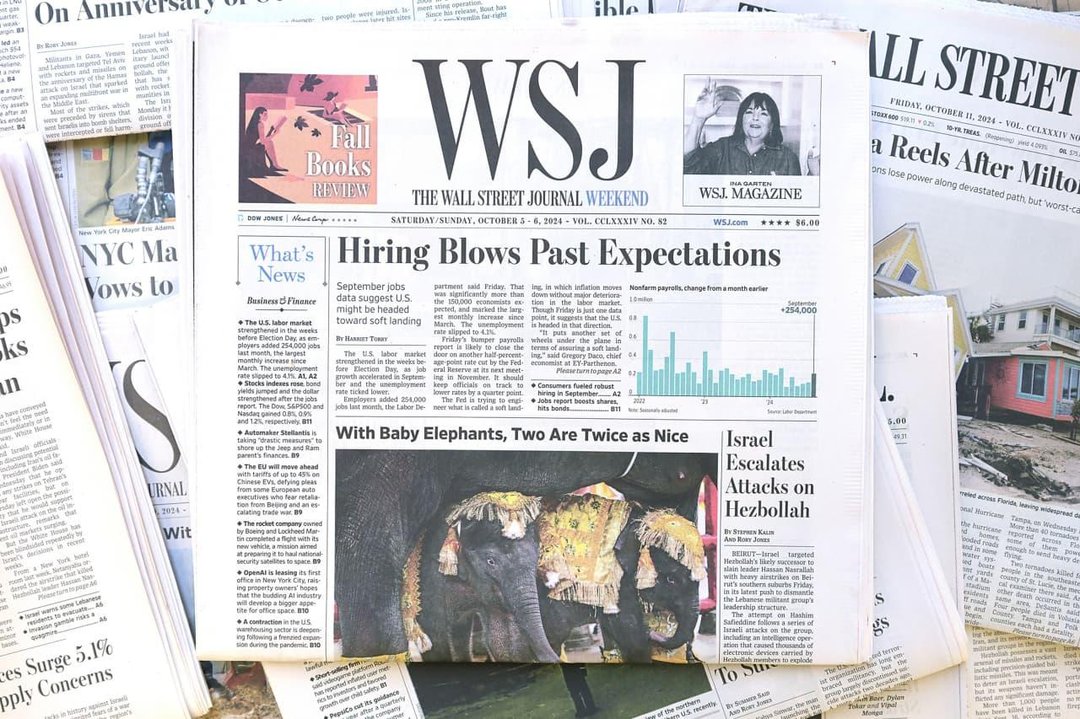
By Spencer Jakab
Oct. 14, 2024
It sounds like an investor’s wildest dream. A surprising experiment shows that it shouldn’t be.
Huge sums are lavished each year on Wall Street economists and strategists asked to gaze into their crystal balls ahead of market-moving economic numbers. When they mostly get it wrong and there is a surprise, the news is big enough to make front-page news in the next day’s print edition of The Wall Street Journal. But what if a trader had an actual crystal ball and could read a copy of the world’s leading business newspaper a day early?

Joe Fornabaio/WSJ
For example, the Journal’s headline on Saturday, Oct. 5, read “Hiring Blows Past Expectations.” The jobs report released the previous morning for September, which showed that U.S. nonfarm payrolls grew by 254,000 compared with expectations of around 150,000 jobs added, helped send the Dow to a record high that trading session. Meanwhile, bonds lost value, with the yield on the benchmark 10-year Treasury note adding to its largest weekly rise in nearly a year.
Knowing the actual movement of markets would be a guaranteed road to riches, not unlike the fictional Biff Tannen in “Back to the Future II” becoming fabulously wealthy when his future self travels back to 1955 with a sports almanac. But what about just the Journal’s front page with a few giveaway details blacked out, such as “stocks soar?” And how about being given a huge pot of money, plus the ability to multiply your bet, to turn your glimpse at the future into a truly vast fortune?
The real-world results, courtesy of a man who learned the hard way about confident predictions and borrowed money, are fascinating. Victor Haghani, a founder of doomed hedge fund Long-Term Capital Management, whose financial quants nearly took down the global financial system a quarter-century ago, now runs money manager Elm Wealth with Chief Executive James White. The company espouses passive, low-cost money management for its wealthy clients and has published a number of plain-English studies and experiments to get its philosophy across.
The latest is the “Crystal Ball Trading Game.” Players are given $1 million in play money and are shown 15 Journal front pages following big economic news randomly selected over the past 15 years. With up to 50 times leverage, multiplying that pot of money sounds like shooting fish in a barrel. Yet it wasn’t, and many players instead shot themselves in the foot. Through Thursday, more than 8,000 mostly financially savvy players had taken a crack at the game. Their median ending wealth after 15 rounds was just $687,986 according to data provided by Elm. Many lost everything.
Players got the basic direction of the stock market right a little less than half of the time. They were a little bit better at guessing the direction of 30-year Treasury bond futures. That is probably because economic news is less ambiguous for bonds, according to Haghani. For stock traders trying to parse the Federal Reserve’s next move, sometimes good news is good and sometimes it is bad. Many times they will even react one way in early trading only for the mood to shift to the exact opposite take before the closing bell.
But how does one explain the median loss of 31%? Surely being able to bet heavily on the really obvious, no-brainer newspaper headlines should make up for a few errors? In fact that proved to be many players’ financial undoing, with a not-insignificant number having negative money by the end. The first lesson from the game, then, might be to curb your enthusiasm in such cases.
Haghani and another colleague did a real-money experiment eight years ago with 61 people versed in finance or economics, including students and employees of leading firms, and even many of them got it wrong. They offered them $25 and a loaded coin with 60% odds of coming up heads. They could flip as many times as they wanted to for half an hour and walk away with up to $250. Almost all should have pocketed that amount if they knew how to size their bets based on their degree of confidence, but only 21% did and, incredibly, 28% lost all of their money.
The second lesson from the Crystal Ball, though, is that markets are made up of crowds with complex emotions. Seeing a bold headline with the actual market moves blacked out won’t tell you how to bet. As in the game, a speculator can just sit one out if the market feels like it could zig when theory tells you it should zag.
And if someone with an oddly familiar face steps out of a DeLorean with a future copy of The Wall Street Journal, make sure they don’t forget to include the stock price listings.
Write to Spencer Jakab at Spencer.Jakab@wsj.com
Dow Jones & Company, Inc.



